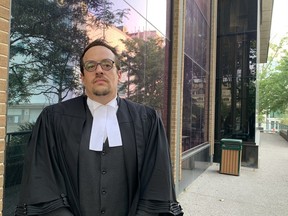
Article content
There were hugs and tears among supporters of Ryan Taylor in a Windsor courtroom Monday night after a jury returned a not-guilty verdict following his second-degree murder trial.
“We had every bit of faith that the jury would do the right thing,” defence co-counsel Bobby Russon later told the Star outside the courthouse.
“We firmly believed since the day we got our hands on the evidence that Ryan was completely and 100 per cent innocent,” he said.
Advertisement 2
Article content
There was a roadside scuffle shortly after midnight on Sept. 23, 2020, between two men who shared a turbulent past and had both been at a local bar, the jury heard in a trial that began four weeks ago before Superior Court of Justice Renee Pomerance.
Ryan tackled Thomas ‘TJ’ McIntyre to the ground that night outside the Seminole Street Bar & Grill. McIntyre, a 38-year-old father of four, suffered blunt force trauma to the head and died four days later, while Ryan, now 35, was charged with murder.
It took just hours of deliberation after the judge gave her instructions to the 12 jurors before the foreman delivered the not-guilty verdict at about 8 p.m.
During his two-hour closing arguments earlier Monday, the accused’s co-counsel Michael Gordner told jurors there was “no doubt” his client acted to “preserve himself from harm” that night.
The jury watched security camera footage that showed Taylor looking behind him and retreating slowly down Seminole Street toward Tourangeau Road, a short distance from the bar, when McIntyre entered the frame charging at him.
The footage captured Taylor taking McIntyre to the ground. Earlier in the trial, two forensic pathologists testified that the cause of death was the initial blunt force trauma to the head, resulting in a fractured skull and significant brain injury.
Advertisement 3
Article content
Jurors had to decide whether Taylor had acted in self-defence or intended to harm McIntyre.
No one wanted him to die
Assistant Crown attorney Andrew Telford-Keogh, in the prosecution’s closing address, cited a nearby resident who testified McIntyre lay motionless on the ground as Taylor delivered more punches. Those punches, after McIntyre’s head had hit the ground, provided a “window” into the accused’s mindset, said Telford-Keogh.
“You don’t straddle a man on the ground” and deliver more punches without an intention to cause harm, he said
But Gordner urged jurors during his closing to disregard the Crown’s key witness, citing several inconsistencies with her testimony.
“We thank the jury for their time and consideration of the difficult issues in this case, and we respect their decision,” Telford-Keogh told the Star later.
“Our hearts go out to Mr. McIntyre and his family, no one wanted him to die. A jury just found that Mr. Taylor didn’t want him to die, either,” Russon told the Star.
“But Mr. Taylor has been living with an anvil above his head for four years. His life has really been run through the wringer. He’s been on a curfew stuck at home for four years. I can’t imagine how good he’s feeling right now.
Advertisement 4
Article content
“I hope that Mr. McIntyre’s family can see that a fair trial was held.”
Recommended from Editorial
The defence had challenged the Crown’s claim that Taylor acted out of “anger and frustration,” encouraging the jury to consider events that occurred inside the bar before the clash between the two men outside.
Jurors watched security footage recorded minutes prior to McIntyre’s arrival, which showed Taylor sitting at the bar drinking a beer when a friend of McIntyre approached and assaulted him, tackling him to the ground.
Minutes later, McIntyre was shown entering the bar. Jurors heard that McIntyre’s friends had contacted him multiple times after Taylor’s arrival to come to Seminole Street Bar & Grill.
Gordner reminded jurors of the bartender’s earlier testimony, when she stated that Taylor had asked her to call police out of fear that he would be “jumped” by McIntyre and his friends. Instead, the bartender devised a plan for Taylor to exit the bar safely.
However, the Crown argued that Taylor’s actions after the assault inside the bar did not reflect someone who was fearful for their safety. Instead of leaving immediately, security footage showed Taylor ordering another beer. When he eventually exited the bar, he waited outside for the bartender to bring him a cigarette.
Article content





